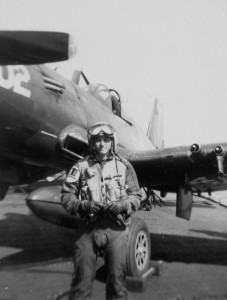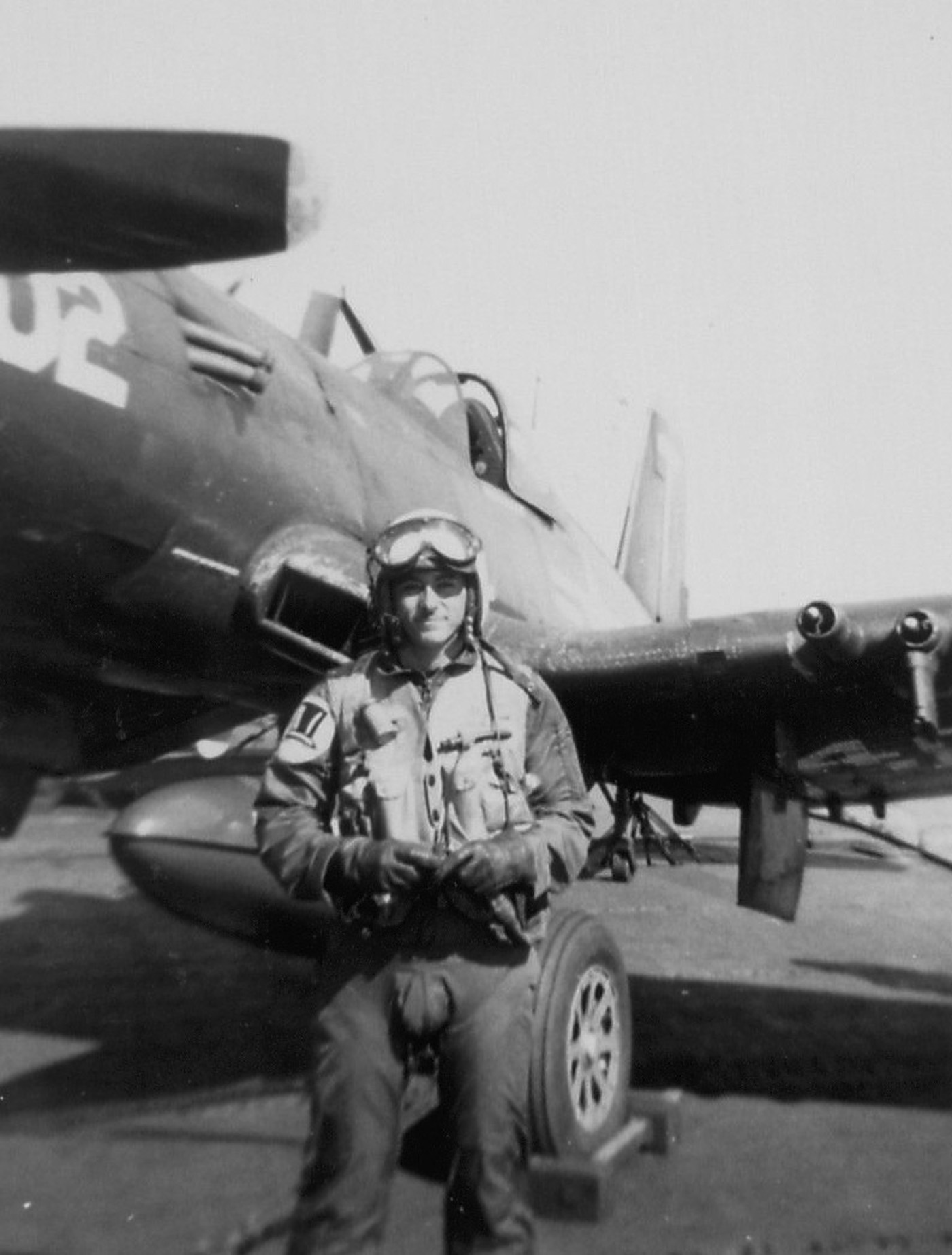By Fred “Crash” Blechman
My first and second crashes, both while in Navy advanced flight training flying F4U-4 Corsairs, were behind me. I was now in the Sixth Fleet, assigned to Fighter Squadron Fourteen (VF-14 “Tophatters”), in Air Group One. We were based at Cecil Field near Jacksonville, Fla., and I was now regularly flying the later model F4U-5 Corsair.
My third crash
On Nov. 21, 1950, I was on a night familiarization flight in F4U-5 #121905. I had flown only 59.3 hours in the previous three months, since I had been on leave for a month after earning my gold Navy pilot wings in late August, and had just recently joined the squadron. I was still a “nugget”—newly winged naval aviator—with only a total of a little over 360 pilot hours. I had been airborne one hour and 27 minutes with four other Corsairs. The first hour was spent on air work familiarization and then our flight returned to Cecil Field to practice night landings.

Fred Blechman in full flight gear and G-suit in front of his F4U-5 Corsair while in the VF-14 “Tophatters” fighter squadron in late 1950.
I wasn’t very used to night flying, especially night landings. Cecil Field was in a remote area, with very little lighting around it, and I found myself tending to be high and fast approaching the runway. I made five touch-and-go non-stop landings with the tail wheel locked to maintain a straight path on the runway, and finally came around for my final landing, which would be a full stop and taxi back to the squadron hangar.
At 12 minutes after 10 p.m., I was making my final approach. The nose was low before pulling it up to slow down and flare out for a three-point landing, so I could see that the Corsair ahead of me had landed, but was still on the runway. As I landed at 90 knots—over 100 miles an hour—I lost all forward visibility!
The Corsair was a “tail-dragger.” It had a solid rubber-rimmed tail wheel rather than today’s more common nose wheel. It also had a very long nose—about 15 feet ahead of the single-seat cockpit—which blocked all forward view when the tail wheel was down. In order to see ahead, you had to turn alternately left and right. We called it “S-turning.” So I unlocked my tail wheel and had enough forward speed to initially use my rudder to do some S-turns to see that I was not about to over-run and crash into the plane that was still ahead of me on the runway. As I slowed down, I began using my brakes alternately to S-turn. I kept looking to see if the plane ahead had turned left onto the taxiway. It had not!
During this maneuvering, a right swerve developed. In attempting to stop the swerve, I applied excessive left brake. With the enormous inertia of the heavy plane, the center of gravity of the aircraft rotated around the main wheels. My Corsair nosed down and the tail rose about 30 degrees! All four blades of the prop hit the runway and bent back, the engine ground to a stop, and the tail slammed back to the ground!
Very embarrassing, since this was purely pilot error. Other than my pride, I wasn’t injured. The only damage was to the prop blades. The squadron commander, WWII ace Robert C. Coats, decided that no disciplinary action was necessary, since he considered that I was relatively inexperienced, and erred in judgment rather than through negligence.
As a result of my accident, the squadron instituted the practice of having a senior officer on the downwind end of the runway when new pilots were conducting night familiarization landings to observe and coach, if necessary, to prevent recurrence of such accidents. Another practice that was adopted was that each landing aircraft was to call the tower and report when clear of the duty runway. So maybe my accident prevented others.
My fourth crash!
During the two years I spent in VF-14, we went on six carrier cruises. Two were extended tours in the Mediterranean Sea with the Sixth Fleet. But several cruises were Atlantic Fleet Exercises (LANTFLEX) usually held in Caribbean waters. It was on one of those short cruises that we were flying off the light carrier “U.S.S Saipan” (CVL-48), considerably smaller than full-size CV carriers. The CVLs had less landing area, fewer arresting wires, but just as many barriers.
The barriers—there were three sets of them—were heavy cables that were suspended above the deck on supports that lifted from the sides of the deck to stop planes that missed arresting wires. Once an aircraft had safely been stopped by an arresting wire, the barrier cables were dropped to allow the plane to taxi to the forward deck parking area.
On Aug. 16, 1951, I had just come back from my second flight of the day in F4U-5 #121818. I made a normal carrier approach and landing, caught the #3 arresting wire, and watched the barriers in front of me drop, allowing me to taxi forward.
Following normal procedure, I allowed the arresting wire to pull me back so a deckhand could release the hook. Now it was up to me to quickly get ahead of the barrier locations so the barriers could be raised behind me, and the next plane would have a “clear deck.” It was a matter of pride to make a snappy taxi forward to the parking area, since we tried to land a plane every 30 seconds or less. I raised the hook lever, hit the wing-folding control, and, following the plane director’s hand signals, pushed the throttle forward briskly to get moving as the wings folded upward.
As I rolled over the barriers, I cut the throttle and started applying brakes so as not to plow into the aircraft parked ahead. The plane director signaled me to slow down, and I tried, but the plane just kept moving forward as if I had no brakes! Putting more and more pressure on the brake pedals until I was practically standing on them, and with the throttle completely off, I continued moving forward, as if I were on ice! The plane slowed down as I skidded forward, but didn’t stop until the still-turning prop chewed off the sheet-metal tail cone of the Corsair parked in front of me!
The propeller wasn’t damaged. The Corsair ahead of me needed a new tail cone fairing and white tail navigation light before it flew again. Other than another blow to my pride, I wasn’t hurt, but puzzled. Had my brakes failed?
No! Inspection showed the brakes were fine. But while our flight had been out on patrol, the ship had gone through a rainstorm and the deck was wet. The rain water, mixed with the typical oil and gas on the deck, made the deck very slippery, so my Corsair had hydroplaned with the brakes locked! Had I been informed that the deck was slippery, I would’ve advanced across the barriers more cautiously.
Actually, the damage to the plane ahead was so minor that an accident report wasn’t even written. But if I didn’t count this as an accident, downing another Corsair, I wouldn’t have had a total of FIVE Corsair accidents, making me an enemy ace! The fifth accident? That’s coming up soon in a “True Tales from the Fred Baron” story.
Fred Blechman’s two flying books, “Bent Wings—F4U Corsair Action & Accidents: True Tales of Trial & Terror!” and “Flying With the Fred Baron,” are available at [http://www.amazon.com].











